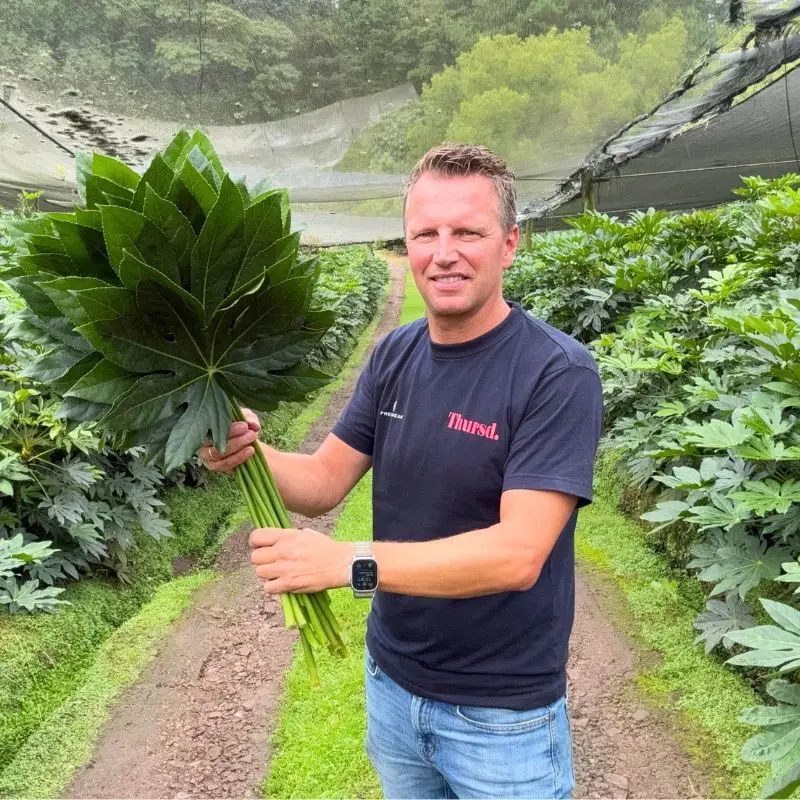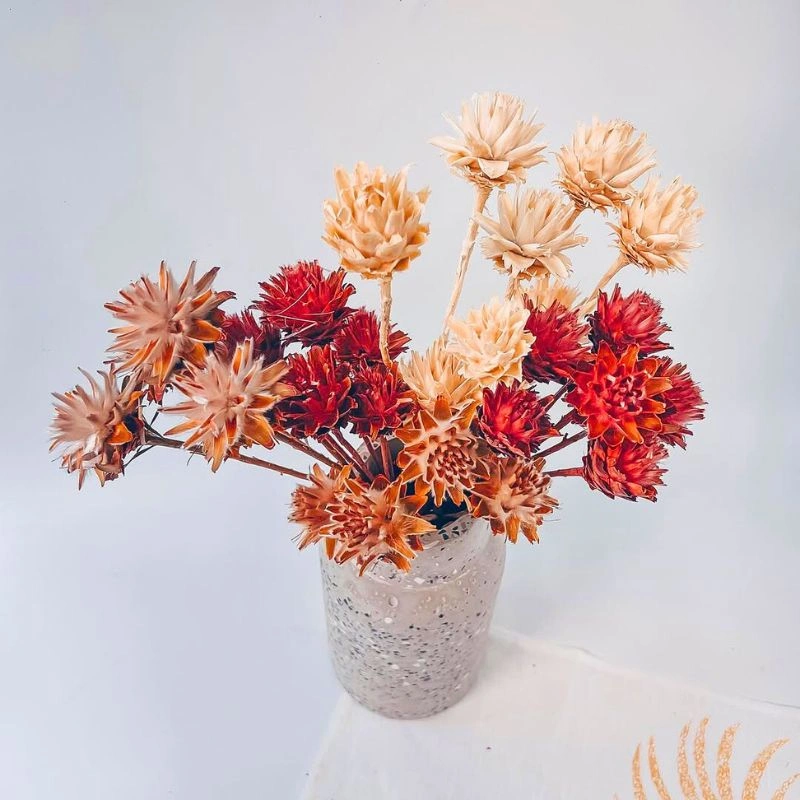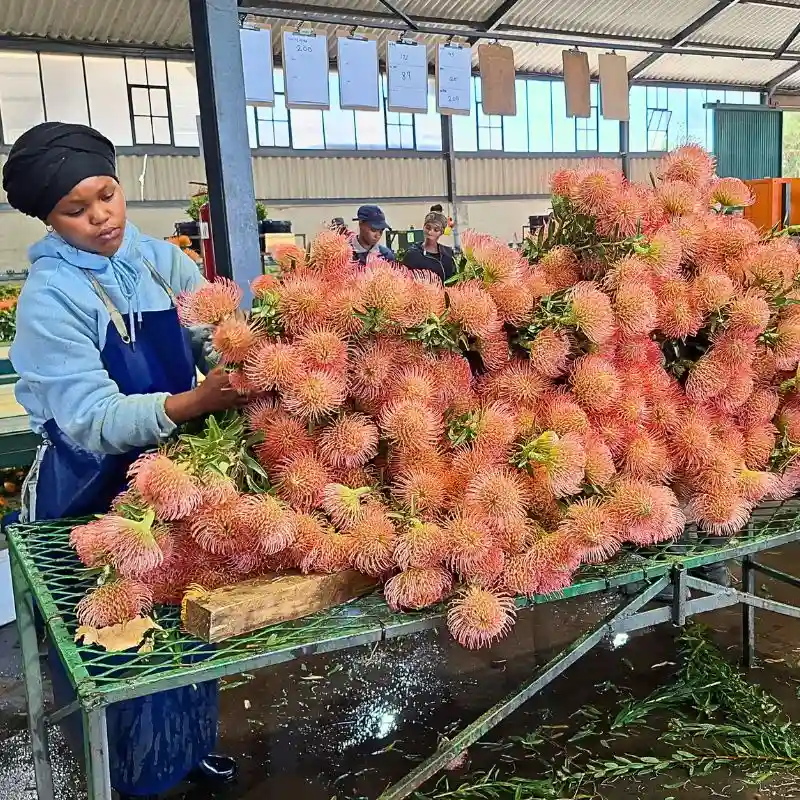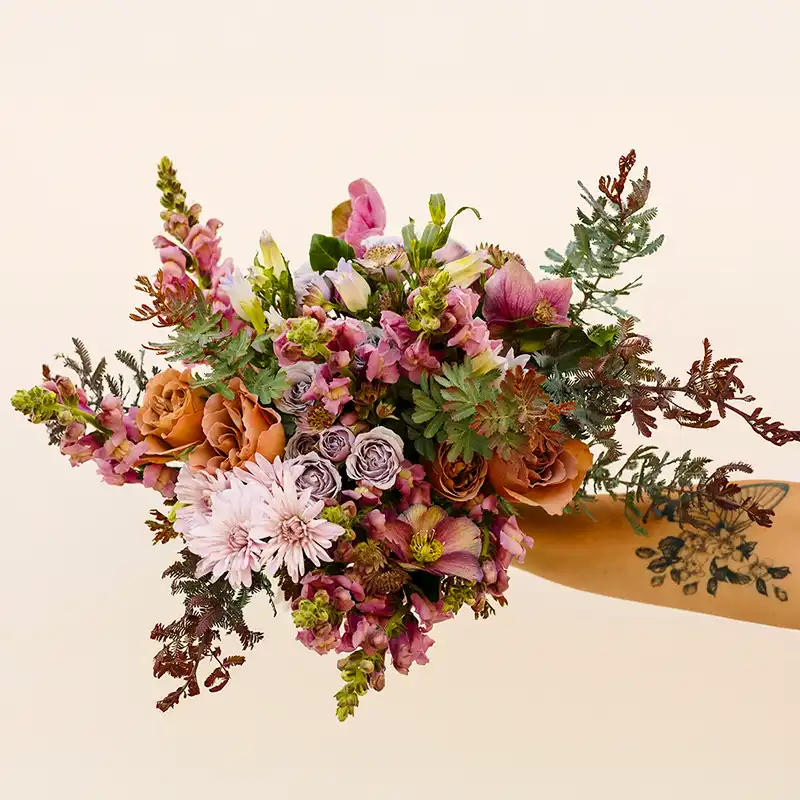The Protea is an emblem of uniqueness and change. This splendid flower is quite unlike your regular cut flower. Hailing from prehistoric times, it bears witness to the planet's evolution. You now get a bit of an idea of why it deserves your attention.
So, let's take a closer look at the Protea family: the Protea flower meaning, its fascinating history, growth habitat, and its care needs. And why this flower definitely deserves your full attention, and a place in your designs and arrangements.
What’s the Origin of the Protea?
A long time ago, nearly 300 million years to be more or less precise, there was already a Protea thriving on the surface of the earth. Unlike today, there were no humans to witness this beautiful plant, and certainly no growers to harvest it for use in floral arrangements. So, how do we know its age?
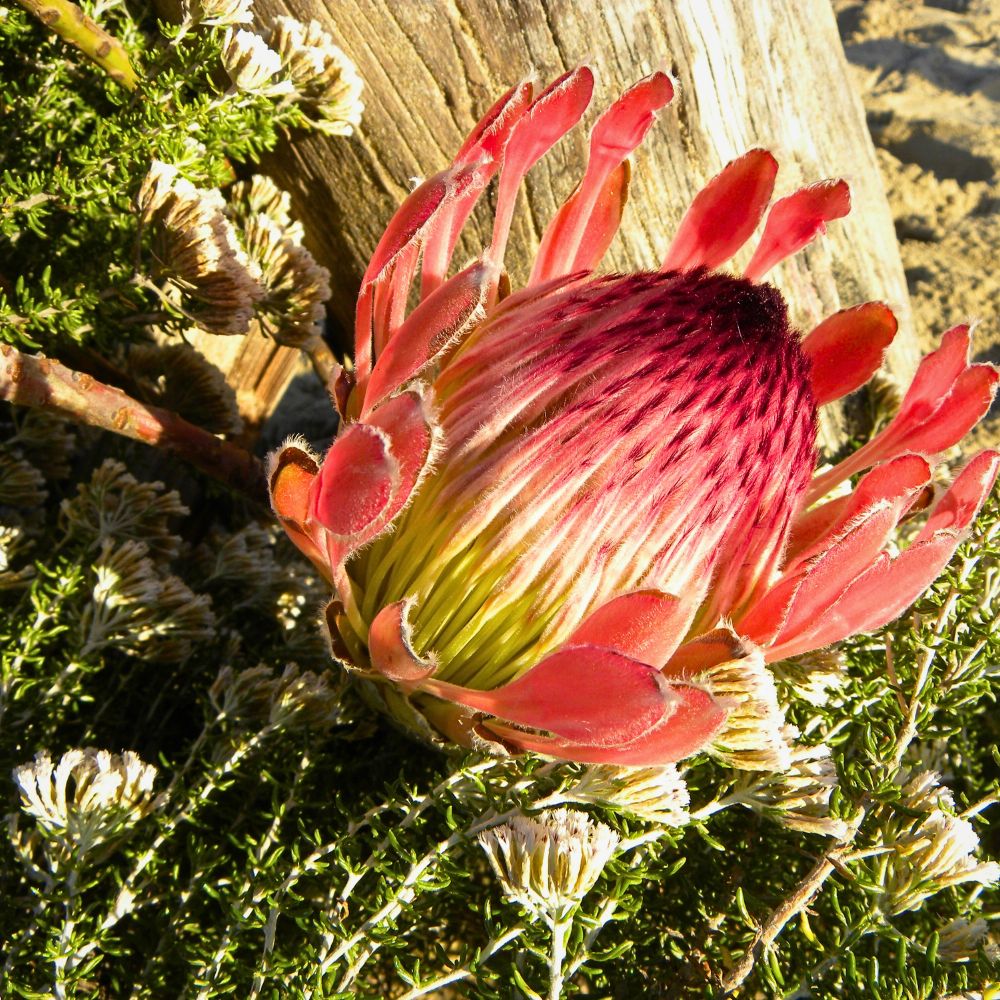
That has to do with some fossil evidence tracing its existence back to the late Carboniferous period from prehistoric times, when we still had one supercontinent called Gondwana. Back then, average temperatures were good for the Protea to thrive, around 12°C (54 °F). Gondwana eventually broke apart, forming continents such as Africa and Australia. As a result, Protea species are naturally found in these regions today, making them native to South Africa and Australia.
The Protea still thrives in specific climates, predominantly the Mediterranean climates found in parts of South Africa and Australia. These environments have wet winters and dry summers, which are ideal for these flowers. They particularly flourish in well-draining, acidic soil and are adapted to survive periodic wildfires, which rejuvenate their growth.
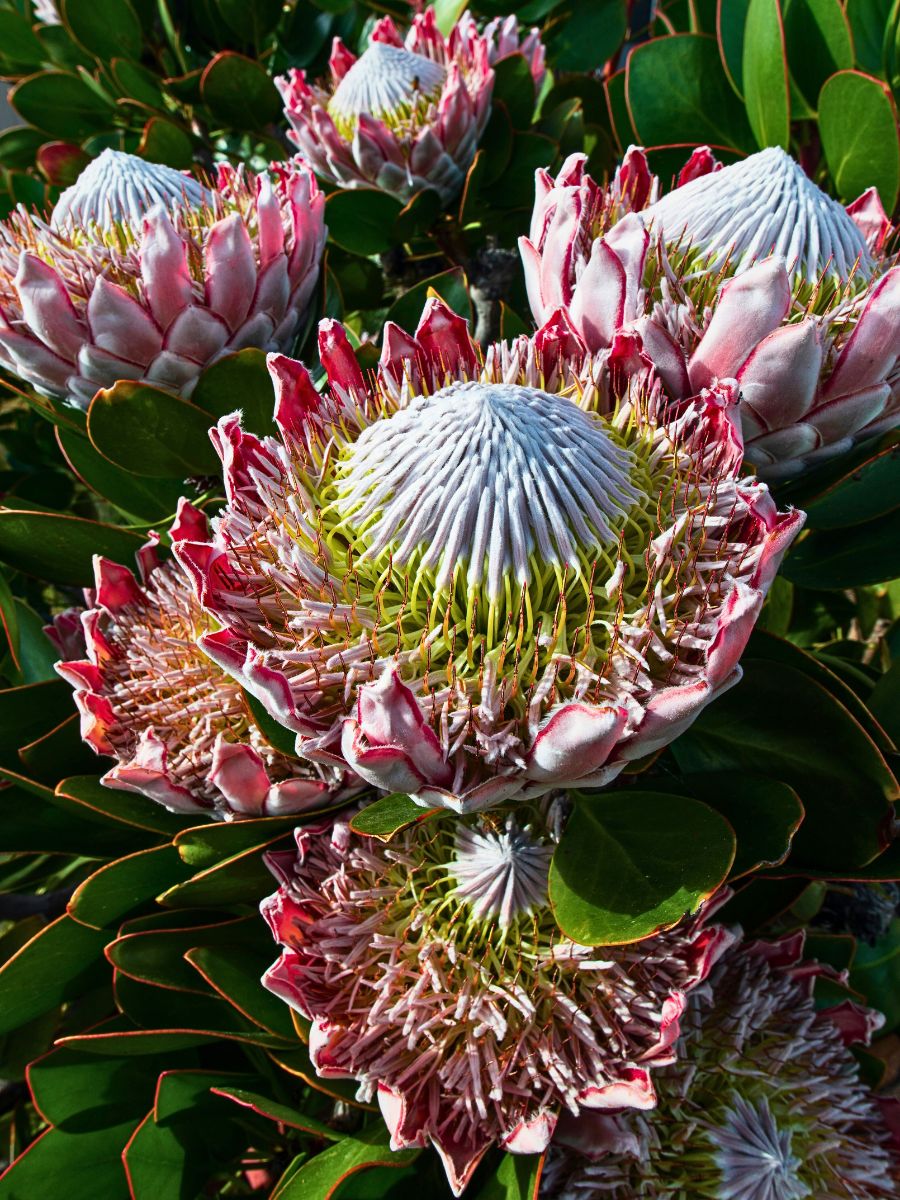
What Does the Protea Flower Mean? Its Symbolic Meanings
The meaning of Protea flowers encompasses everything from transformation to diversity and courage. The meaning of the Protea flowers can be traced back to the Greek god Proteus, known for his ability to change form at will and take on many shapes. This aptly reflects the diversity of Protea species and, by extension, their symbolism of embracing change.
Perhaps the most iconic Protea flower is the King Protea, whose large size and distinctive shape exude regal beauty. The King Protea flower meaning is all about strength, courage, and leadership, and can be used to denote the embracement of one's inner power and motivation to stand tall amidst challenges.
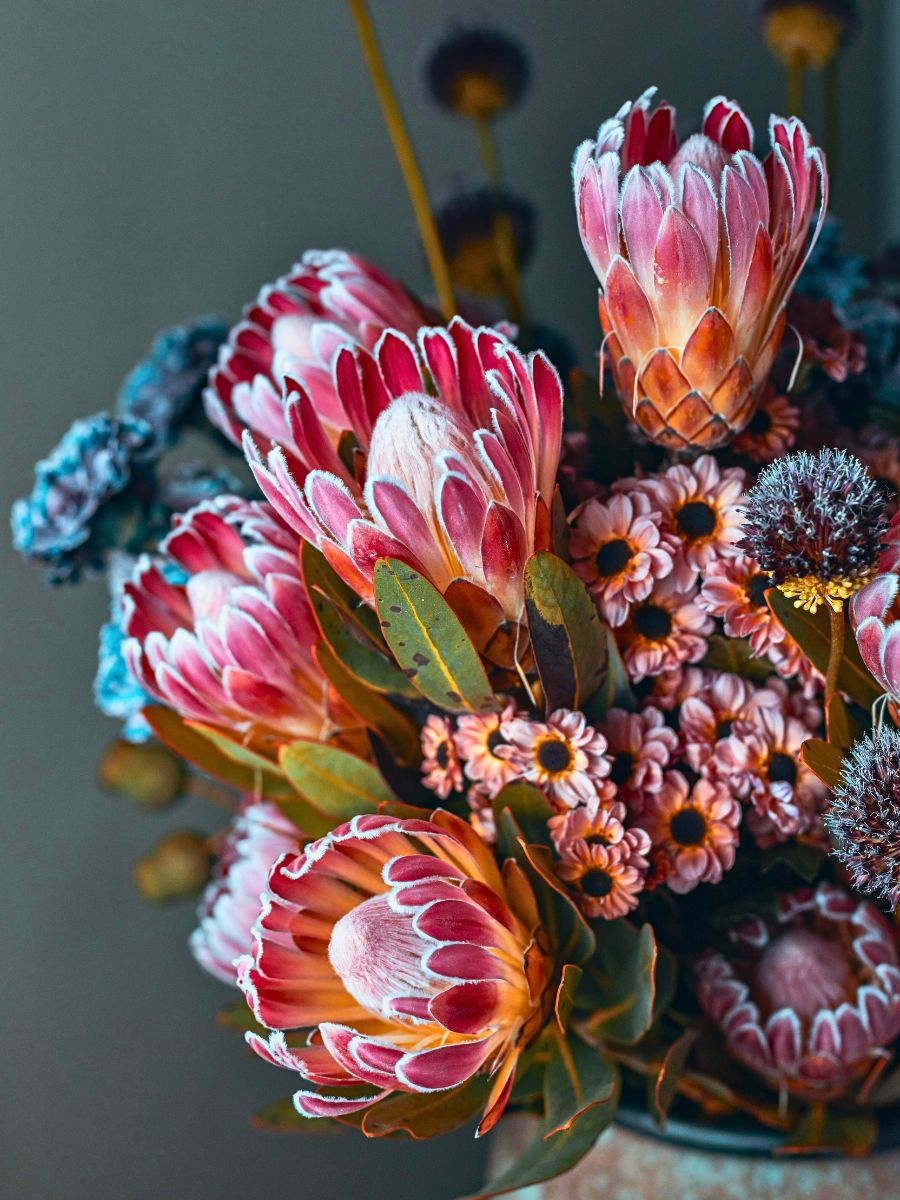
In South Africa, the King Protea represents the nation's unity and is the country's national flower. Its resilience and ability to thrive in challenging conditions make it an emblem of strength and endurance, a symbol of the nation's journey through history.
Another remarkable variety is the Pink Ice Protea, which is renowned for its delicate pink petals with icy white tips. This exquisite Pink Ice Protea represents purity, innocence, and grace. Its soft, feminine allure adds a touch of elegance to floral arrangements.
The Queen Protea, yet another variety, commands attention and embodies femininity, beauty, and grace. Also known for its majestic appearance, it represents the strength and resilience of women, making it a popular choice for bouquets (especially bridal bouquets) and floral tributes at weddings.

What Does Gifting a Protea Mean?
In floriography, gifting a Protea flower conveys messages of admiration, uniqueness, and celebration, making it a perfect gift. It is a gesture that acknowledges the recipient's remarkable qualities and individuality and expresses gratitude for their personal growth and journey. Whether it is presented as a single flower or incorporated in a bouquet, the Protea flower often leaves a lasting impression.
In floral arrangements, Proteas naturally become the focal point. Their sculptural form and strong presence work well in centerpieces, bridal bouquets, or large installations. Paired with softer flowers and foliage, they give designs a more modern, slightly wild character that feels intentional rather than overly polished.

Proteas Appearance and Varieties
Proteas generally have large, distinctive flower heads, often surrounded by colorful bracts (modified leaves). But their diversity in appearance is astonishing: there are over 1,600 known species in the genus, ranging from shrubs to tall trees. Among the most popular varieties are:
King Protea (Protea Cynaroides)
Because this is the true king of Proteas, it is usually called King Protea as well. This variety has the largest flower head among Protea species. With petals arranged like a crown around a central disk, the King Protea has a strong, architectural look. Unmistakably recognized by its large, crown-like blossom, it is South Africa's national flower. The King Protea flower meanings include courage, leadership, and transformation.
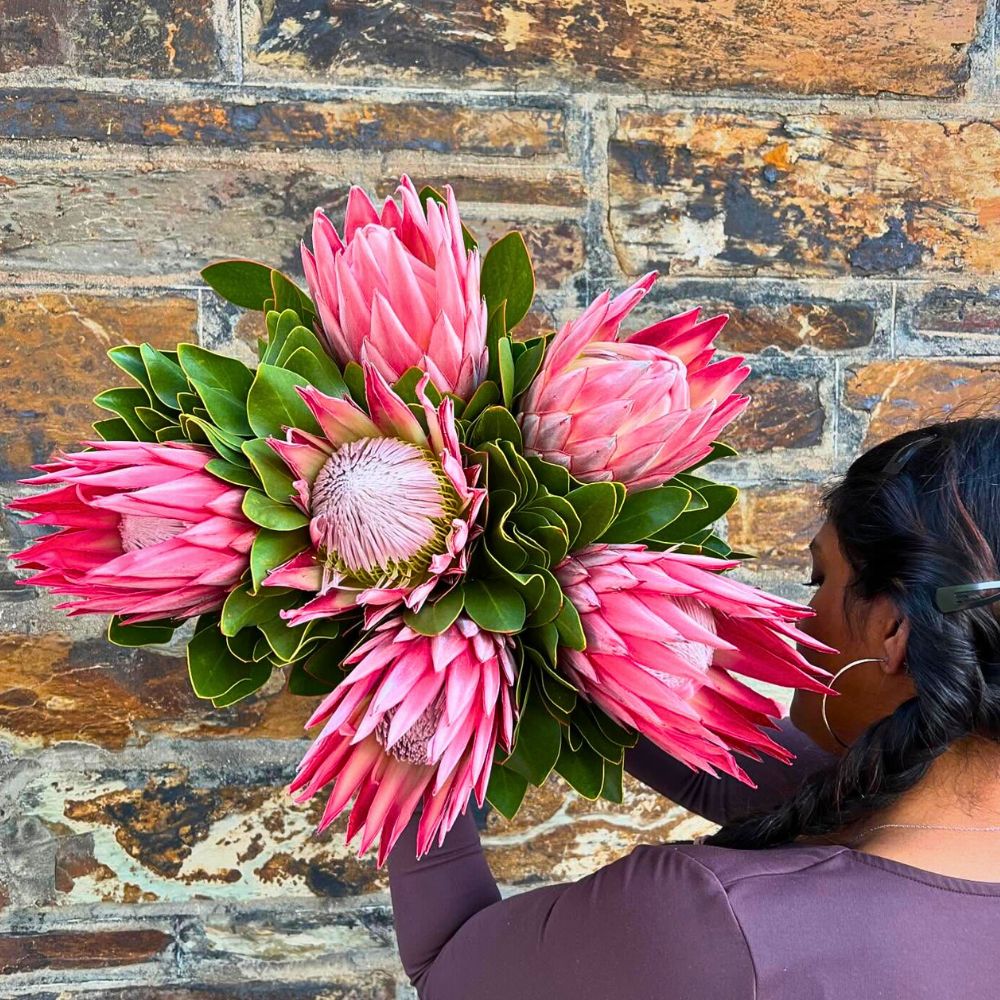
Queen Protea (Protea Magnifica or Protea Barbigera)
Protea Magnifica, also called Protea Barbigera and nicknamed the Queen of the Proteas, is the second largest variety after the King Protea. As elegant as its name suggests, the Queen Protea showcases large, bowl-shaped, woolly flower heads that exude grace and beauty. With its pastel shades of pink, purple, and cream, this Protea variety adds a touch of femininity and elegance to the setting.
In the past, this Protea flower was especially popular during All Saints' Day. In recent years, it has become a popular guest of honor at weddings and other festive occasions. You can read more about the Strikingly Beautiful and Fluffy Protea Barbigera.
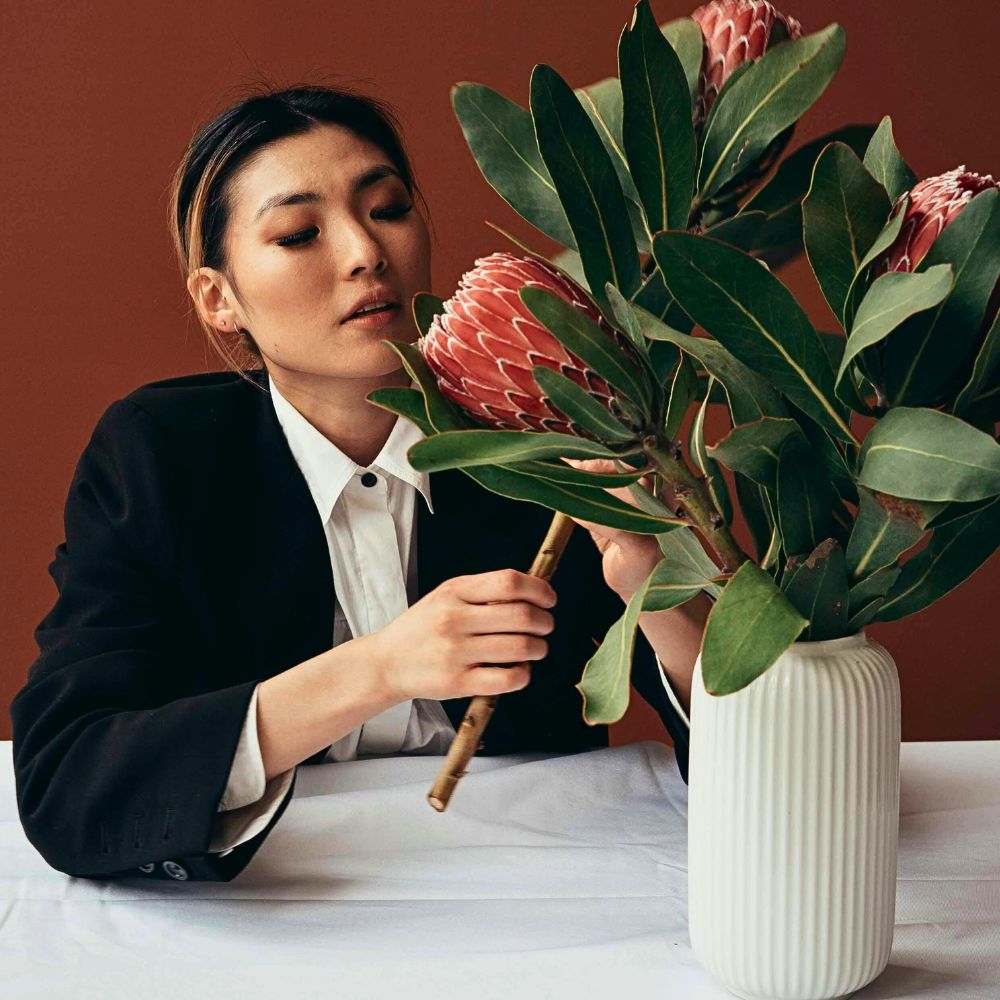
Protea Ayoba Arctic Ice
Ayoba Arctic Ice is an impressive and magnificent variety of the white King Protea. The label 'Ayoba' is the household brand name of the South African breeder Future Fynbos, and is grown by Zuluflora.
The color is truly white, inside and out. The flower head of Protea Ayoba Arctic Ice is one to watch; it is among the largest in the entire Protea family. This makes it an easy focal stem in any fuller floral artwork.
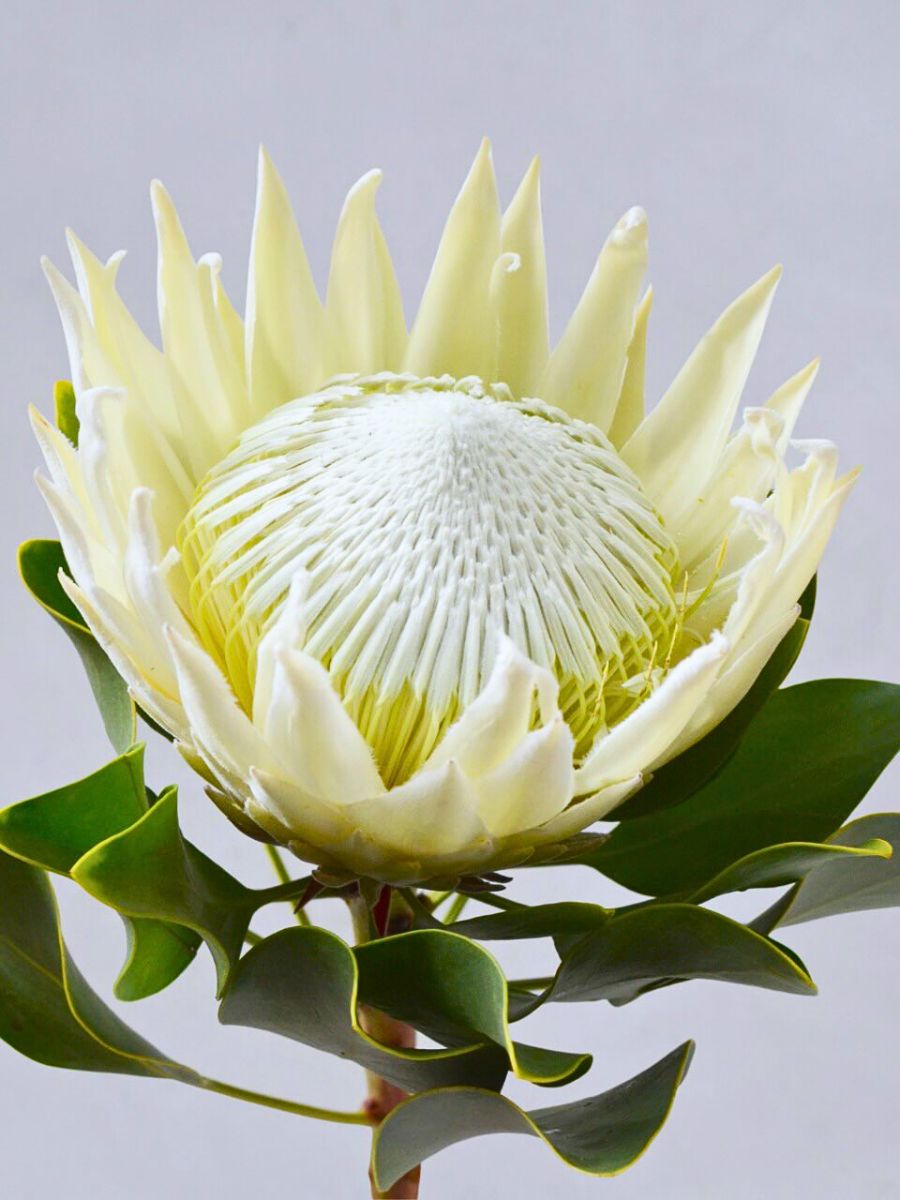
Protea Repens
The Protea Repens is also known as Sugarbush Protea. It is known for its elongated flower head. Repens has no fringing or fur like many Proteas do, and its flowers have a more elongated, geometric look. It naturally occurs in a range of colors from white or very pale yellow to pink and red.
Protea Repens Red was historically a source of sweet nectar for indigenous people and had medicinal uses. In South Africa, Proteas are generally still known as 'Suikerbos', a name derived from 'Sugarbush'. The whole flower has an appearance of being waxy or shiny, due to the stickiness of the nectar. In South Africa, they have several folk songs about the Sugarbush, which is also used as a term of endearment for young women.
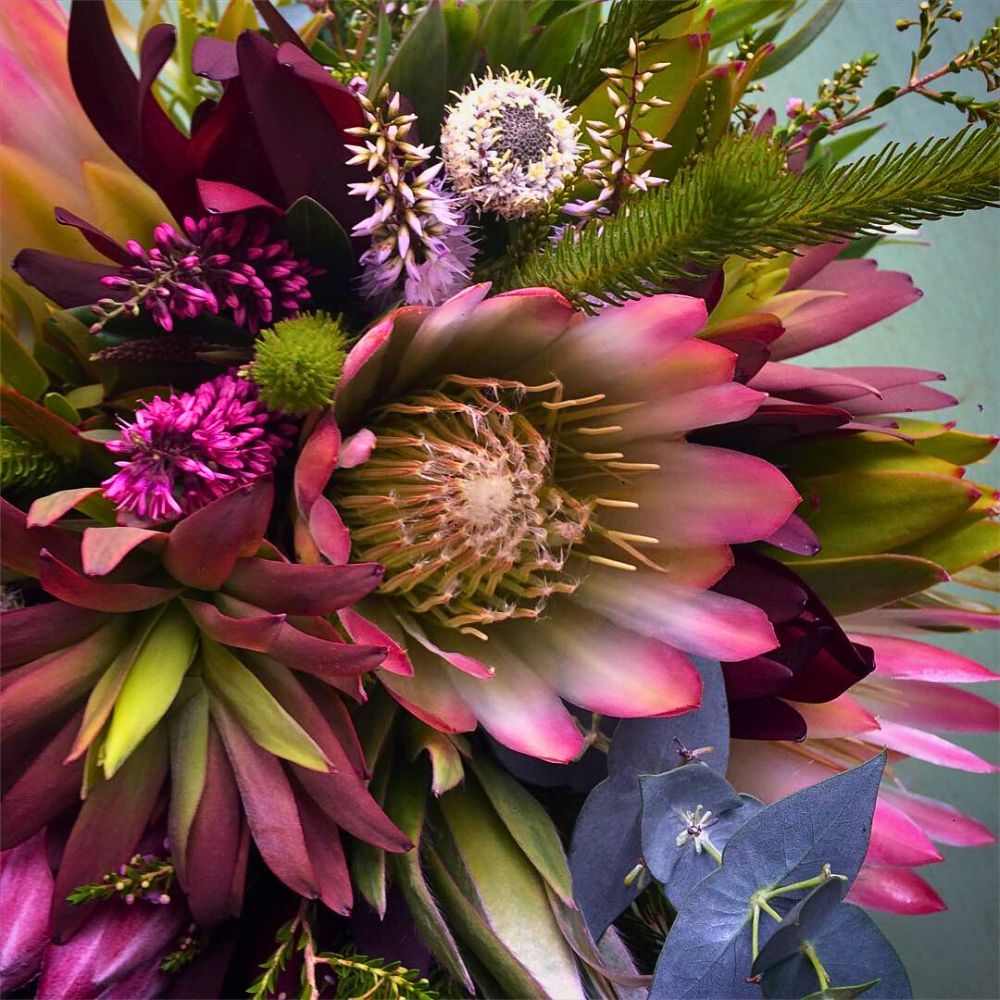
The Sugarbush Protea has no fringing or fur like many Proteas, and its flowers have a more elongated, geometric look. It naturally occurs in a range of colors from white or very pale yellow to pink and red.
Protea Pink Ice
Protea Pink Ice is the hardiest of all Proteas, yet it is soft on the outside. Its deep dusky pink flowers and ivory-colored bracts can be enjoyed fresh or dried. Include its compact oval flower head, and you have a florist classic. These frosty-looking flowers are often used in winter-themed arrangements, adding a cool seasonal feel and a slightly rustic character to any collection.

Protea Blushing Bride (Serruria Florida)
While it is not often referred to as a true Protea, the Protea Blushing Bride deserves a mention for its exquisite beauty. Because of its soft white and pale pink flowers, an all-time wedding favorite is probably the smallest of all Proteas, which is the Blushing Bride. This flower is also known as Serruria Florida or Pride of Franschhoek.
You can get enchanted by this blog: 'Protea Blushing Bride Is My Elegant 'Jewelry' Flower' from renowned French designer Gaétan Jacquet to know more!

Leucospermum Cordifolium (Pincushion Protea)
Leucospermum is a group name for a wide variety of Pincushion Protea flowers. They all differ significantly from the 'regular' Protea varieties, with their appearance resembling a brightly colored pincushion filled with pins. No surprise that one of its most used nicknames is Pincushion Protea or Pincushion Flower. The Pincushion Protea flower is characterized by its spiky appearance and intense, saturated hues.
But it has more common names, like Firework Flower and Nutans. That last name can be credited to Scottish botanist Robert Brown, who complicated matters in 1900 by suggesting it ought to be 'Nutans'. Long story short: use whatever name you like, but know there might be some confusion.
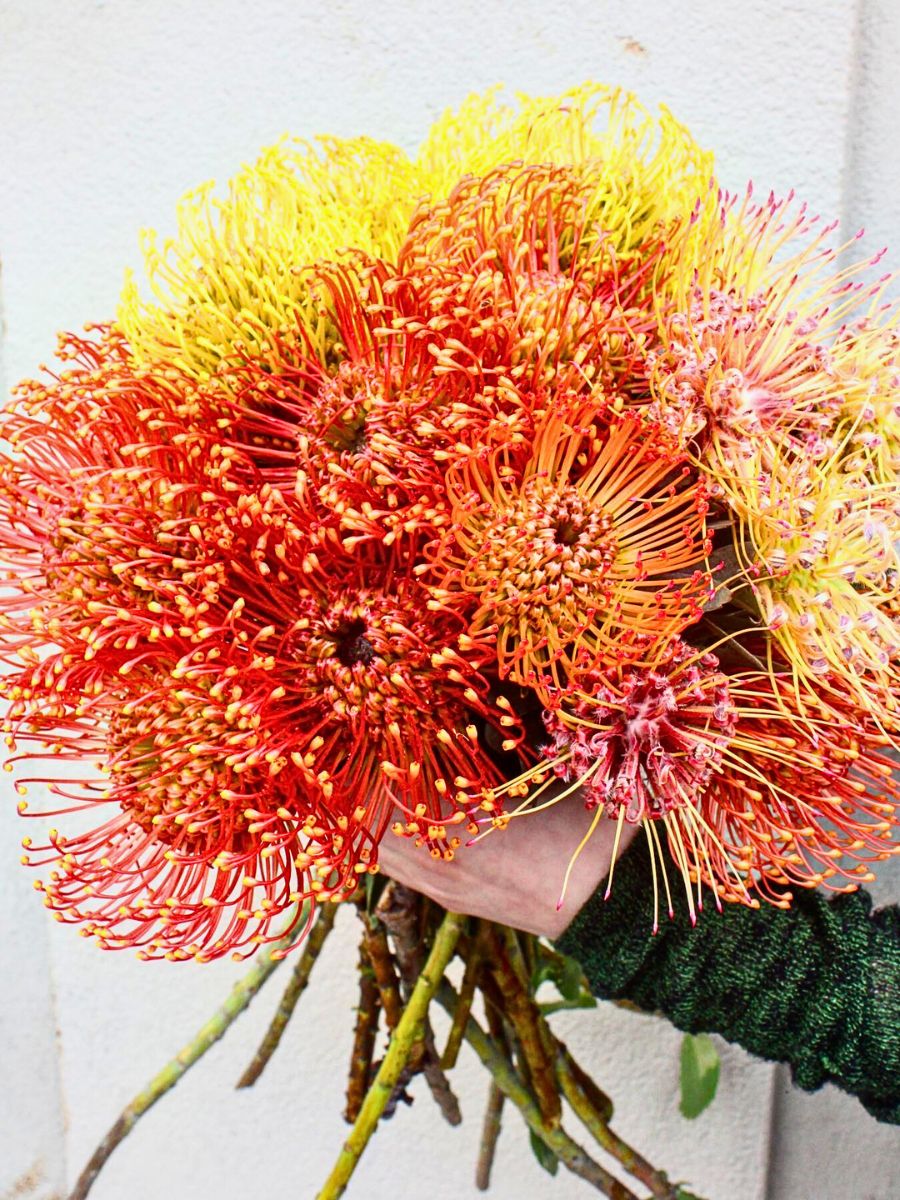
Telopea Waratah
Protea Waratah has a short season, but in that short amount of time, it is highly sought after. The flower heads are dense and symmetrical, with many small tubular flowers packed closely together. Protea Waratah, also called Telopea, is well-known for its clear red color and symmetrical head of tubular flowers.
Aside from being a popular cut flower, the Waratah is also a cultural symbol in Australia. The name Waratah comes from an indigenous Aboriginal tribe, as it is native to the southeastern parts of Australia (New South Wales, Victoria, and Tasmania). The best-known species in this genus is Telopea speciosissima, which has bright red flowers and is the state emblem of New South Wales (NSW), representing the region's natural heritage and origin.
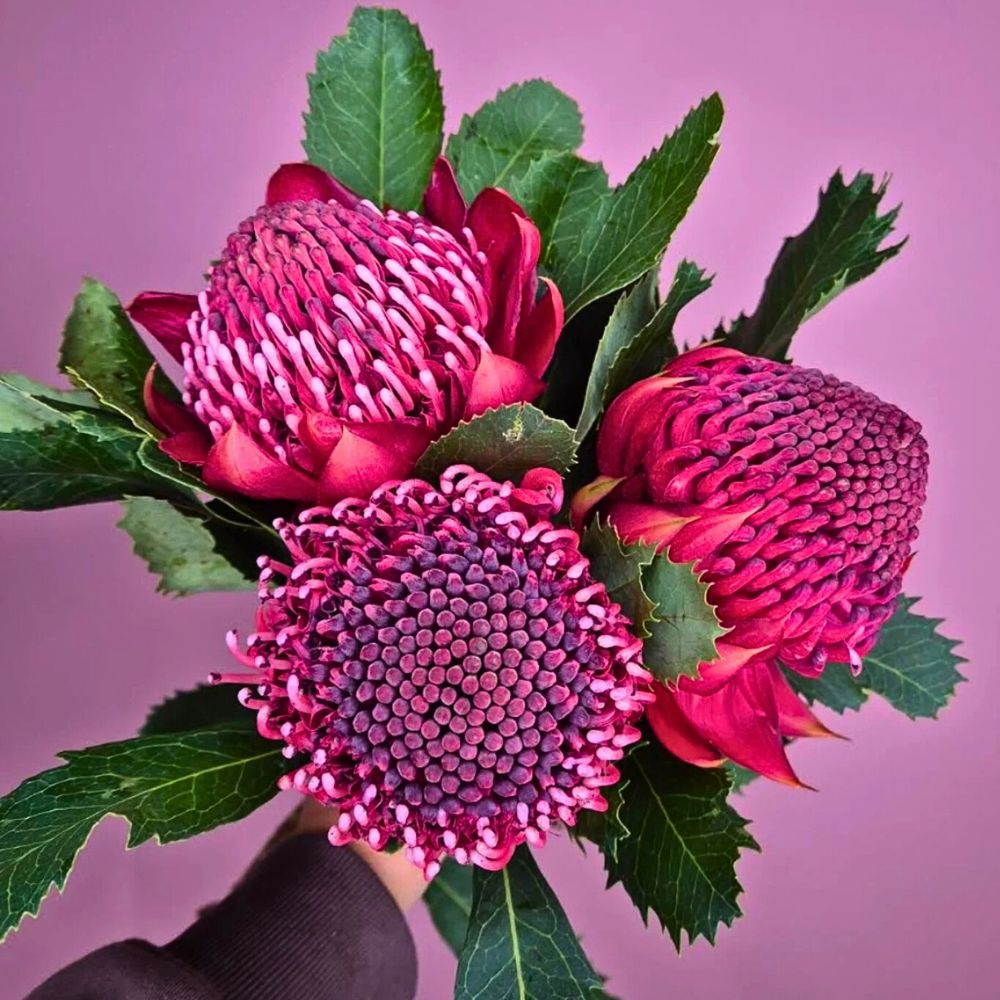
Get to learn more about the Waratah as The Perfect Addition to This Season's Floral Designs.
Leucadendron
Did you know that Leucadendron is also a type of Protea? Maybe you did not realize this, because this flower is often regarded as foliage since it does not have a lush flower on top of the stem, perhaps just a button. Still, it is one of the most used Proteas in the world.
There is not just one 'Leucadendron', but many, in different shapes and sizes, with strong color ranges, crowned with big and small cones. The most popular one is definitely the Leucadendron Sarafi Sunset. See how floral designer Coral Shortt used Leucadendron Sarafi Sunset in her 'Africa Bouquet'.

Banksia
Banksias are Australian Protea wildflowers that are popular garden plants and, as cut flowers, a very popular choice because of their size. They are easily recognized by their characteristic flower spikes, woody fruiting cones, and heads.
Just like Leucadendron and Leucospermum, Banksia has many sub-varieties, of which the most common are Banksia Coccinea, Baxteri, Hookeriana, Sceptrum, and Prionotes.
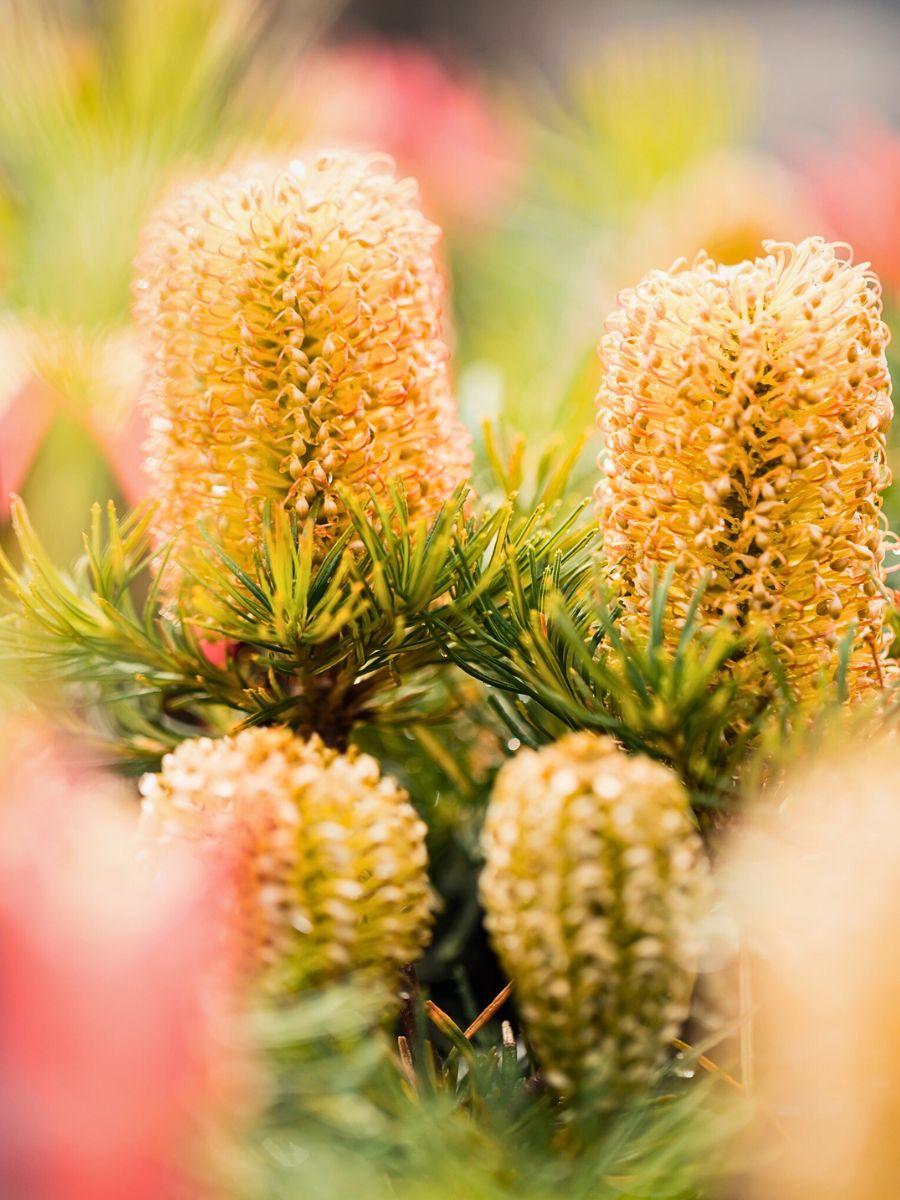
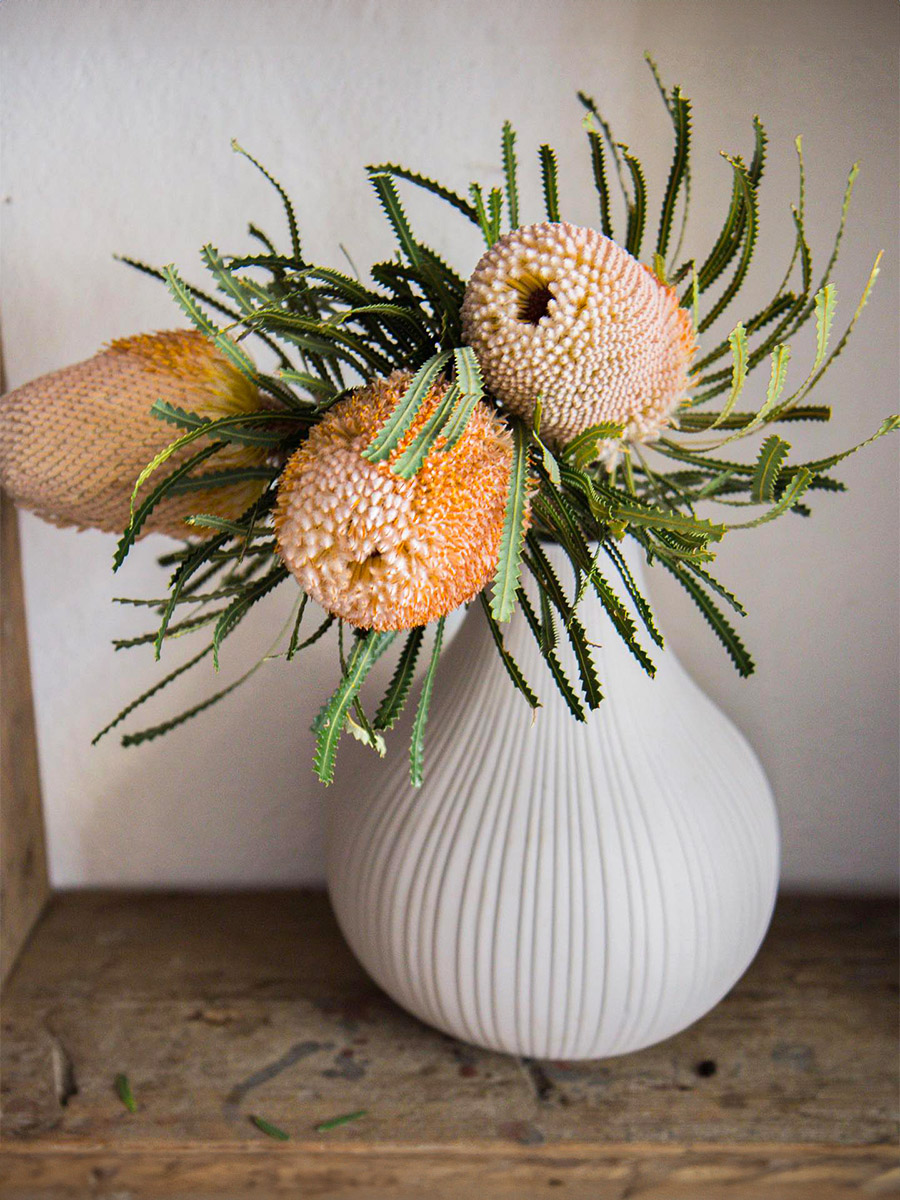
Fun fact: Some Banksia varieties also grow well in countries like Hawaii and Israel.
And Many More
There are so many Proteas that it is impossible to get a complete overview here. Therefore, this is just your starting point to discover the world of this kingly and queenly flower. If you want to meet all their relatives, brace yourself: the family comprises 83 genera with about 1,660 known species, mostly living in the southern hemisphere, like Australia and South Africa, and in the upcoming country of Colombia, at grower Rosamina. Some can be found in southern Europe as well, such as in Portugal, Hawaii, and Israel.
There are well-known growers from Australia and South Africa, including Zuluflora and Arnelia. If you are a wholesaler, retailer, or florist in Europe, you might find a good source at Adomex through their specialized label OrcaExotics.
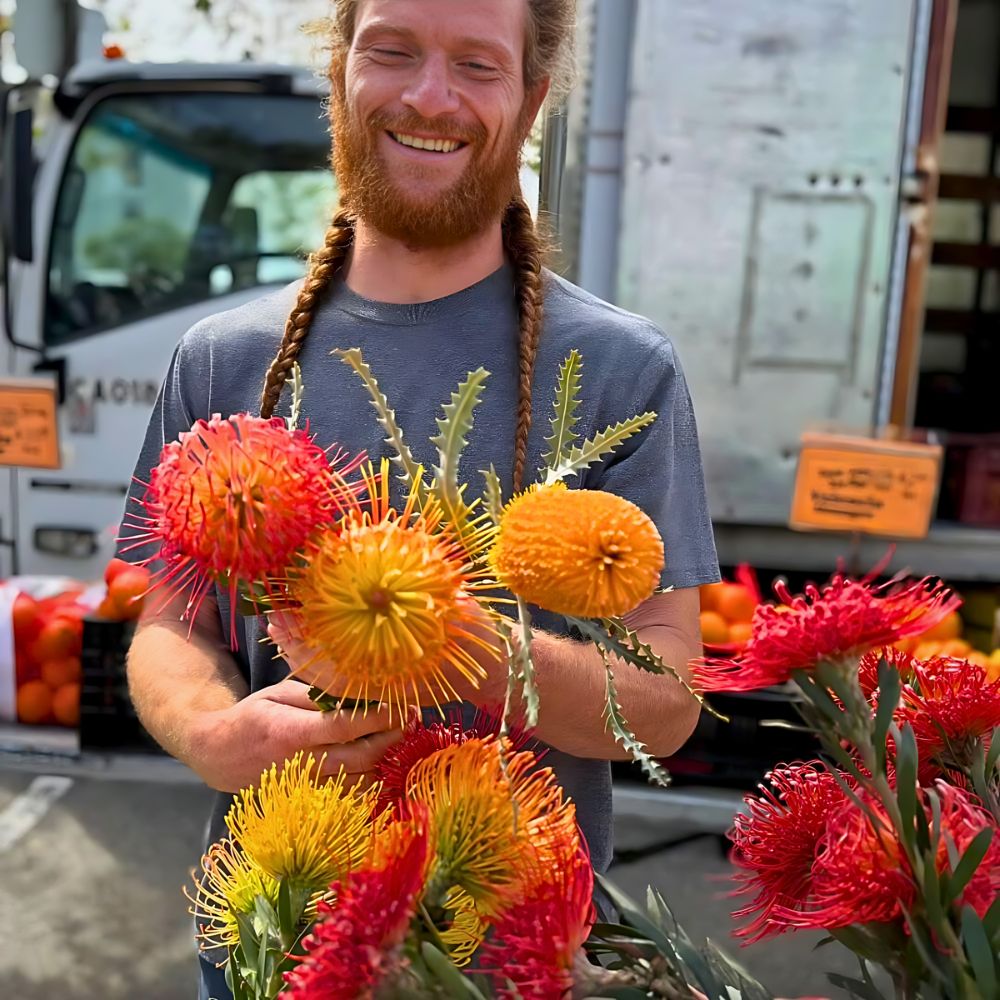
Dried Proteas? How Do You Dry These Flowers?
Drying Protea flowers is an innovative way to create long-lasting floral displays and add an intriguing touch to your decor. The drying process for Proteas is relatively simple, and with just a little patience, you can get long-lasting stems to keep on display.
To begin, choose Protea flowers that are fully mature but haven't started to wither. Selecting those at the peak of their beauty ensures that they will retain their color and shape during the drying process. Popular Protea varieties for drying include Pincushion Protea, King Protea, Pink Ice Protea, and Queen Protea.
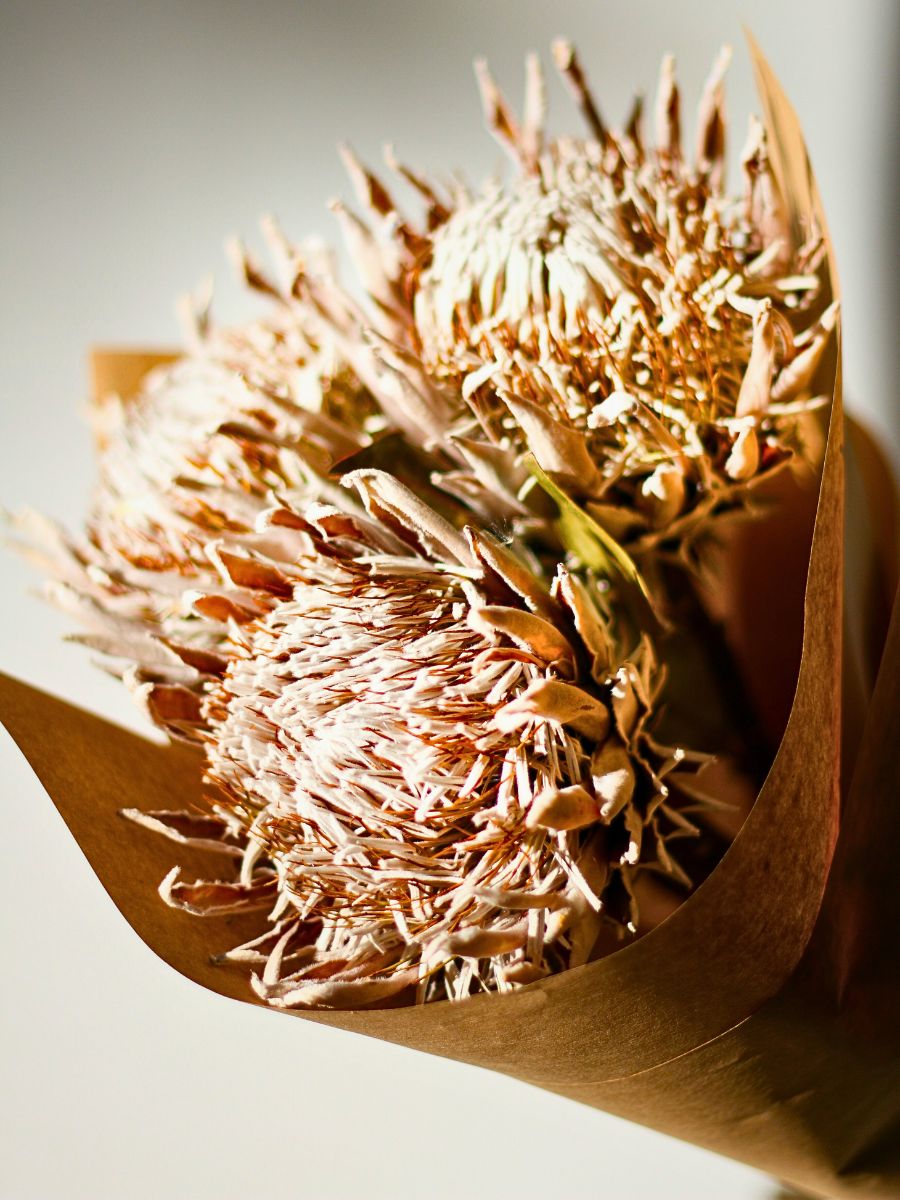
The first step in drying Protea flowers is to remove excess foliage and leaves from the stems, keeping the focus on the striking flowers themselves. Then gather the Protea stems into small bundles and secure them with a rubber band or twine. One needs to be mindful not to overcrowd the bundles, as proper air circulation is crucial for effective drying.
After the Protea bundles are prepared, hang them upside down in a well-ventilated area. Choose a warm, dry location away from direct or harsh light to avoid color fading. The Protea flowers will gradually dry and retain their shape as moisture evaporates from the petals.
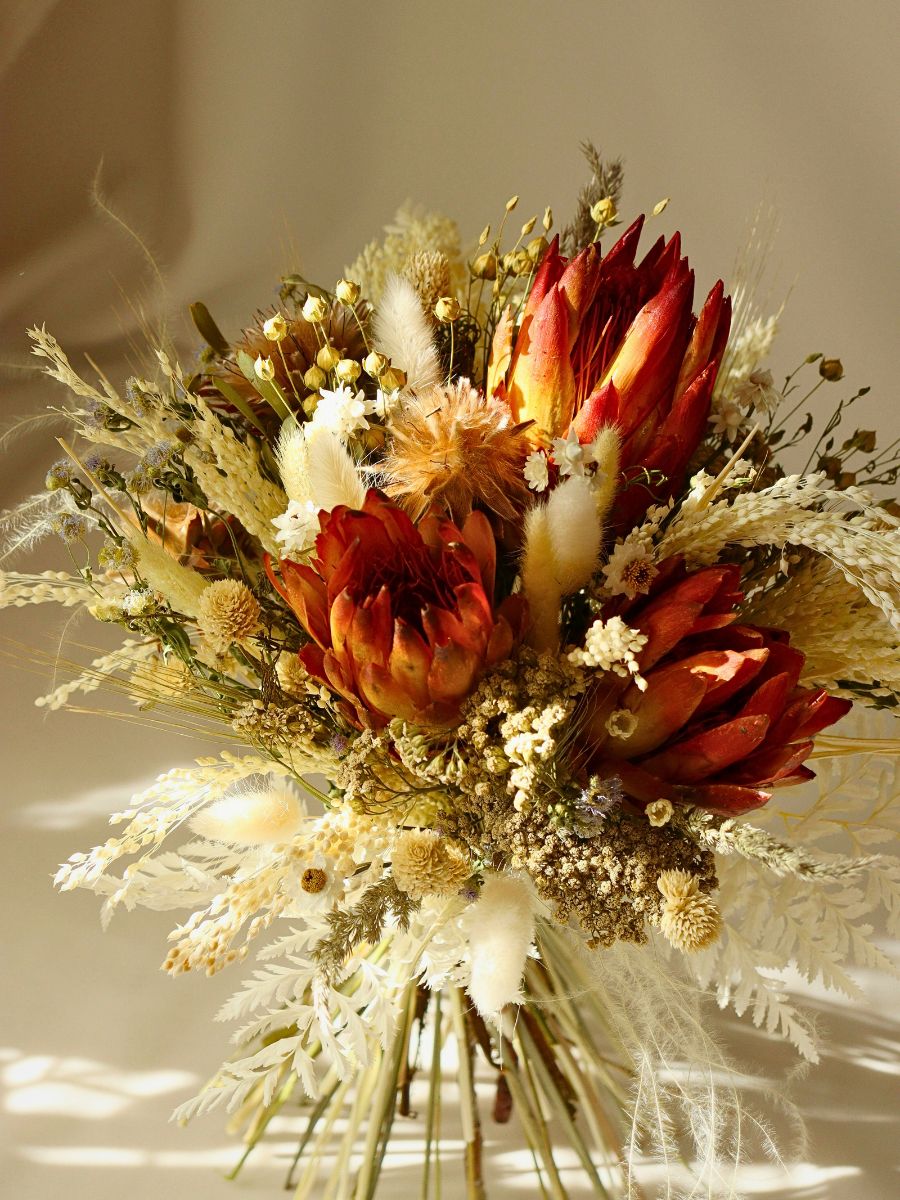
The process of achieving dried Protea flowers can take anywhere from two to three weeks, depending on the variety and environmental conditions. During this time, monitor the flowers regularly and check for any signs of mold or rot. Also, remove any damaged flowers to prevent moisture from spreading.
After the Proteas have completely dried, carefully remove them from the hanging bundles. The flowers should feel crisp and papery to the touch. You can now incorporate dried Proteas into floral arrangements, where the dry Protea flowers make a statement on their own or when combined with other dried flowers and foliage.
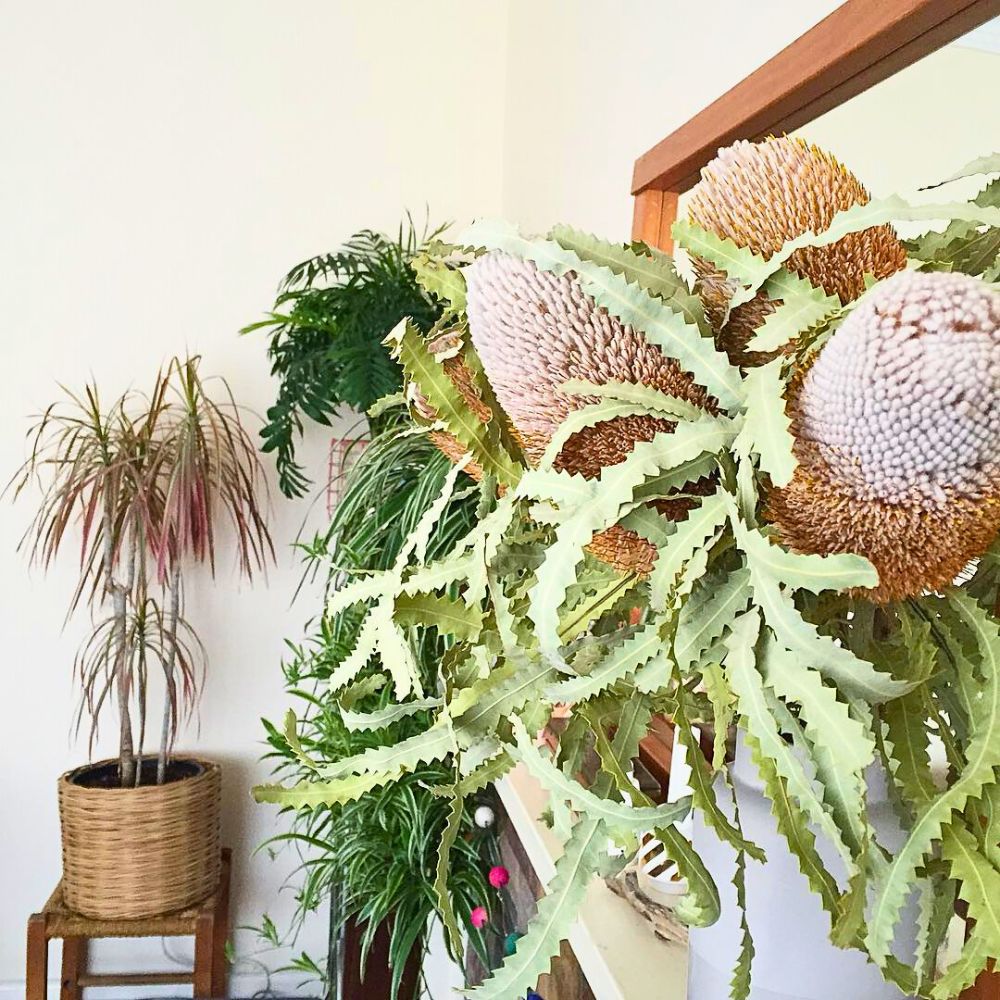
To maintain the beauty of the dried Protea flowers, display them in a dry location away from direct sunlight and humidity. With proper care, they can retain their charm for months or even years.
How to Care for Protea Flowers?
To ensure that Protea flowers retain their character and longevity, proper care is essential. It is therefore important to note that these flowers require specific conditions to thrive. Since these exotic beauties are native to regions with a Mediterranean climate, characterized by warm, dry summers and mild, wet winters, replicating these conditions in your setting will provide the ideal environment for your Protea plant.

When planting, choose a well-draining soil mixture that mimics their natural habitat. A sandy soil blend with good drainage will prevent root rot and maintain the health of your Protea plant.
Protea flowers are relatively low-maintenance once established, but require regular watering during the growing season. Therefore, water them deeply but infrequently, allowing the soil to dry out between waterings. Overwatering can lead to root rot and damage the plant's health. During their dormant period, reduce watering to prevent waterlogged soil.
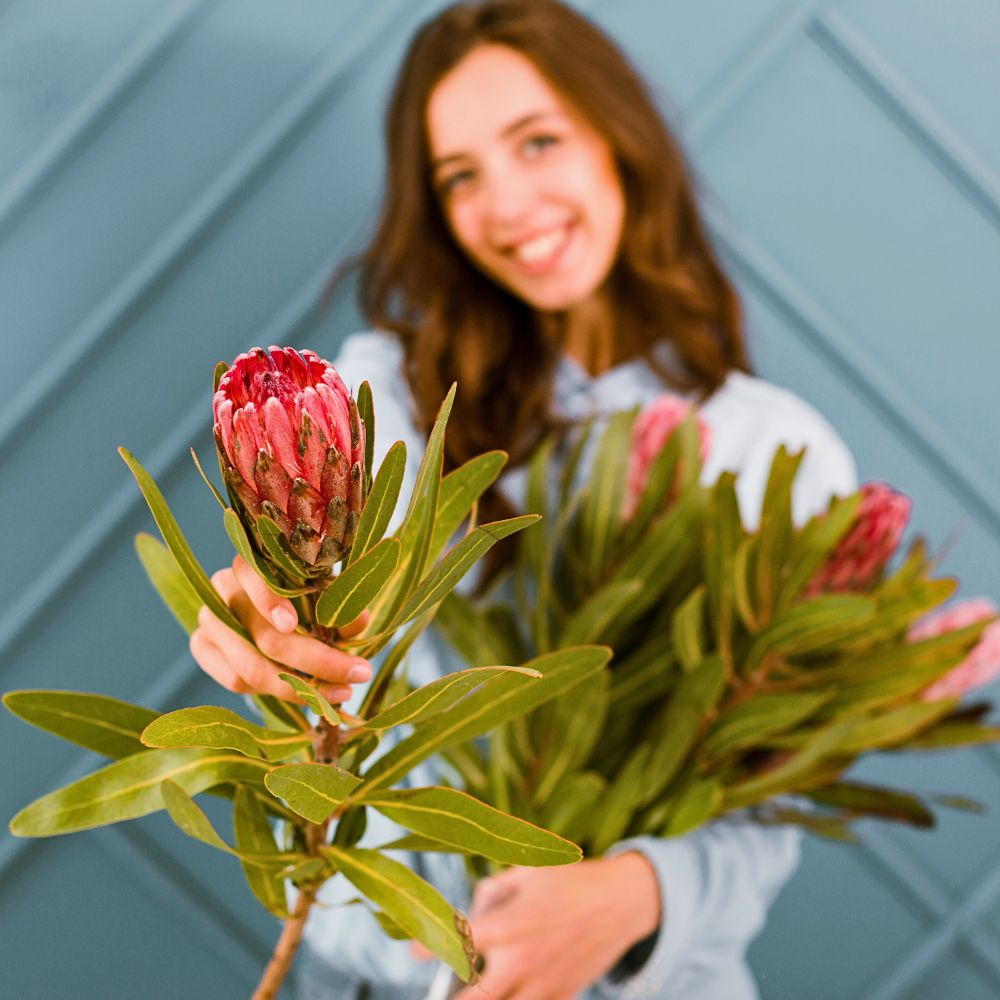
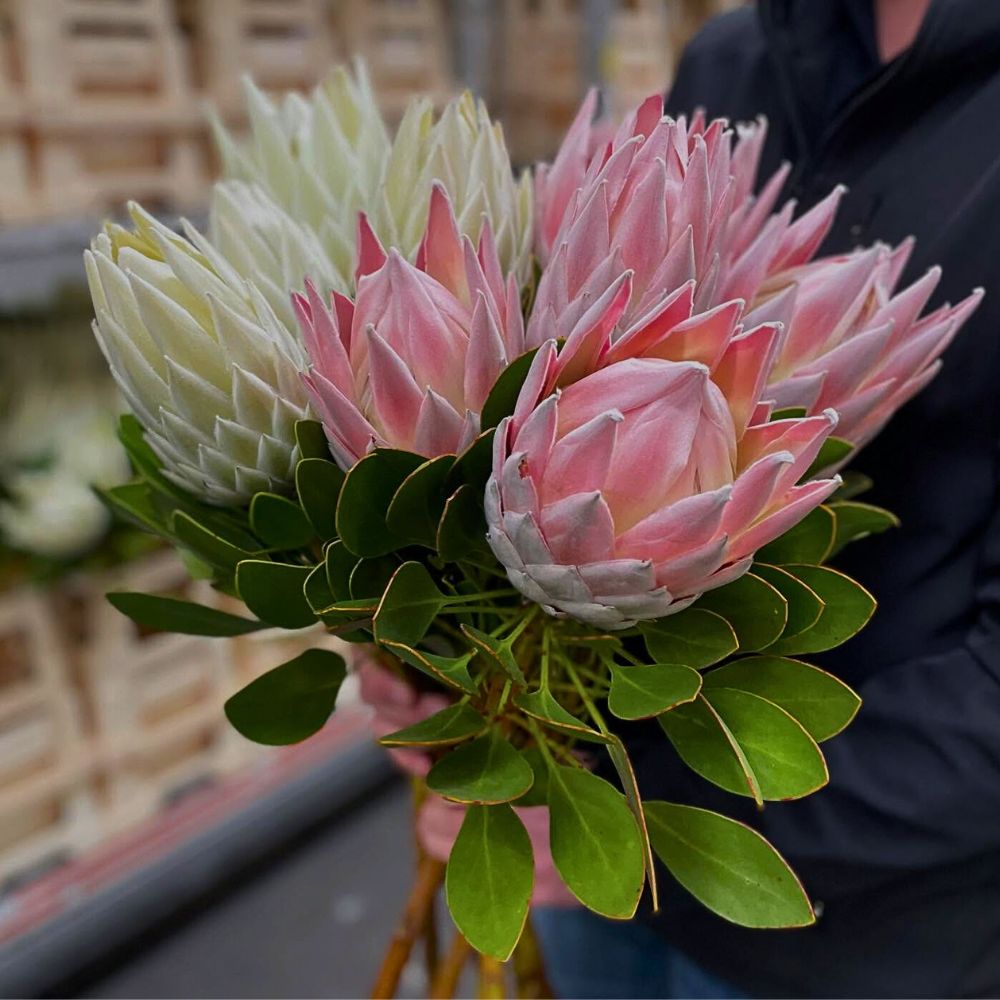
In terms of sunlight, Protea flowers need full sun. Place your Protea plant in a location that receives at least 6 hours of direct sunlight daily. This promotes vigorous growth and ensures the best possible color display.
Also, while Protea plants are generally hardy, they can benefit from a nutrient boost. Fertilize them with a slow-release, low-phosphorus fertilizer specifically formulated for acid-loving plants. Apply the fertilizer in spring and early fall to provide the necessary nutrients for healthy growth and prolific flowering.
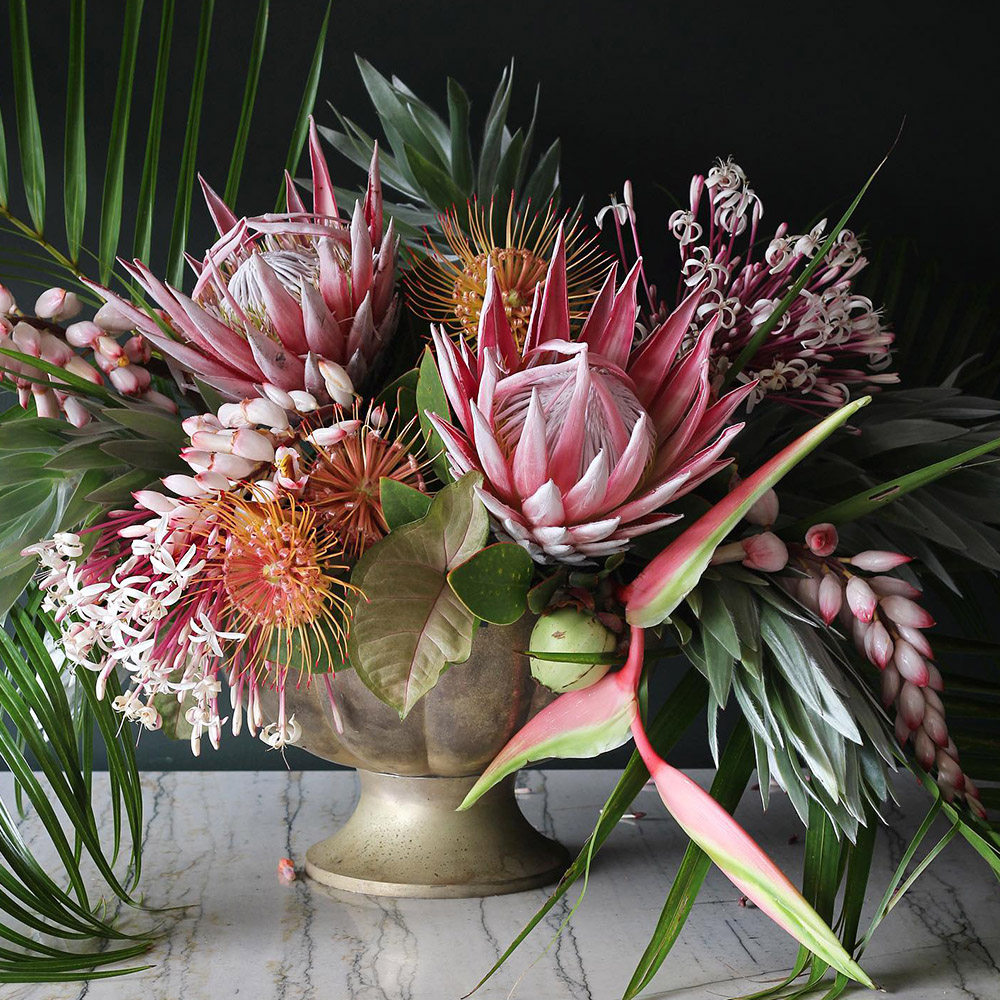
Pruning plays a vital role in maintaining the shape and health of your Protea plant; therefore, after flowering, remove spent flowers and any dead or damaged branches to promote healthy growth. However, avoid excessive pruning, as Protea flowers develop on older wood, and pruning too much can limit future flowering.
Just one more thing, to maximize their lifespan in cut flower arrangements, cut Protea flowers when they are fully open but still firm to the touch. Then immediately place the stems in a clean vase filled with fresh water. Change the water every few days and trim the stems slightly to enhance water absorption, helping your Protea arrangements stay fresh-looking for as long as possible.
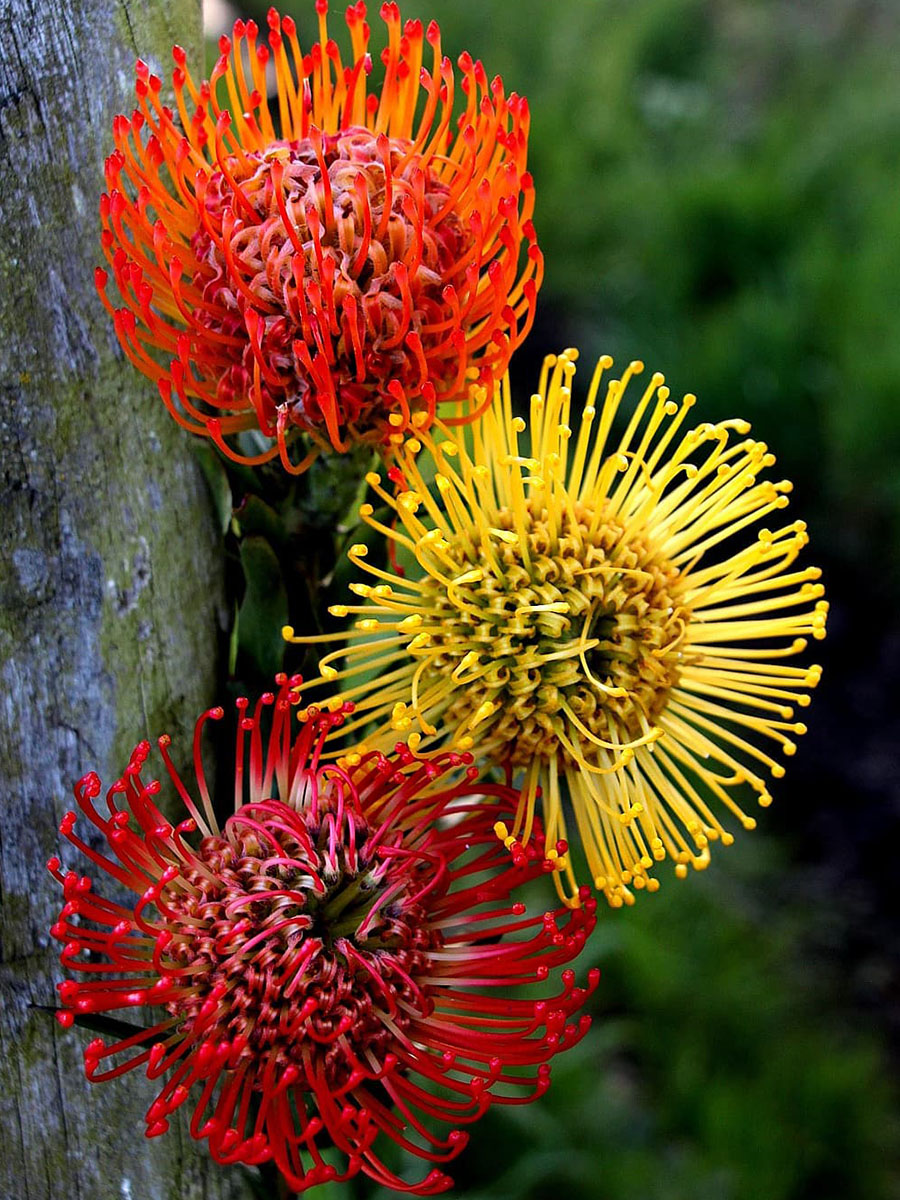
Now that you know quite a lot about them, you realize just how versatile and popular Protea flowers can be for designs and cut flower arrangements, thanks to their unique appearance and long vase life. It’s just about time you try them too!
Feature image by freepik. Header image by Cecilia Kusel



